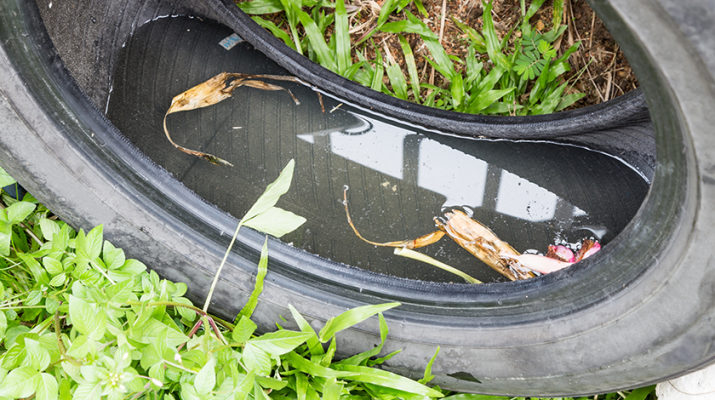Erie County expert: There are as many as 35 varieties of mosquitos in the region but only a few have been found to carry disease
By Julie Halm
While Buffalo and its surrounding communities may be of the urban and suburban ilk, residents are still exposed to a number of insects with problematic bites as spring turns to summer.
Mosquitos, black and deer flies, bees and ticks are some common antagonists in the area, but there are several steps people can take in order to protect themselves.
According to Alexandra Murr, nurse manager at Degraff Memorial Hospital, ticks can be found just about anywhere, including the backyards of homes in the city. The insects seek out warm places such as the armpit, groin or scalp.
“They’re programmed to find somewhere dark and hidden to hide out so you don’t find them,” added Gail Burstein, Erie County Commissioner of Health.
According to Murr, for those planning an outdoor excursion in any area that might have ticks, some steps to prevent tick bites include wearing long sleeves and pants, tucking pants into socks and wearing light colored clothing so that the small bugs are easier to spot.
When the weather is too hot for long sleeves, Burstein suggests bug spray with between 20 and 25 percent deet, which is safe for children as well, although parents should consult their pediatricians.
Those who have been outdoors should also perform thorough checks of themselves and children and pets should also be inspected by an adult.
While these measures can help to prevent a bite, there are several steps to take in the event that a bite has already occurred.
A pair of tweezers can be used to remove the bug and should be placed as close to the base of the tick’s head as possible, according to Murr. A rocking motion should then be used to avoid creating separate pieces and leaving the head or mouth of the bug in the skin. The area should then be cleaned thoroughly with soap and water and treated with a triple antibiotic.
Murr also advised putting the bug in a jar in case there are issues later on. One such potential issue is Lyme disease.
The most well-known symptom of Lyme disease is the bullseye rash, but according to Health Commissioner Burstein, identifying the illness is not quite that simple. The rash typically develops as a small, red blotch at the site of the bite and then grows and becomes a bullseye. Burstein noted, however, that only about 75 percent of Lyme disease patients will develop that symptom and that the rash can also develop in other places.
Other symptoms can include fever, chills, headaches, fatigue, muscle and joint aches and pains and can develop between three and 30 days following the bite. If detected early, a simple antibiotic will treat the issue, but if left unchecked, Lyme disease can become much more serious.
“If people are not treated, they can get late-stage Lyme disease,” said Burstein. “They can get a stiff neck, more rashes, arthritis with severe joint pain and swelling, you can see visible swelling in the joints, people can develop paralysis in one side of their face. They might have intermittent pain in their joints and bones and muscles, it can develop irregular heartbeats and palpitations. People can become dizzy and short of breath, they can have severe central nervous system inflammation where their spinal cord or brain can become inflamed causing unconsciousness and coma and short term memory loss.”
Ticks are not the only pesky pest found in this area. Mosquitos can be both annoying and dangerous if infected with West Nile virus.
According to Peter Tripi, senior public health sanitarian and supervisor of the vector control program for the Erie County Health Department, there are as many as 35 varieties of mosquitos in the county but only a few of them have been found to carry the virus.
While residents can try to prevent individual bites, the first step is to minimize mosquitos’ favorite breeding ground — standing water.
According to Tripi, stagnant swimming pools, ornamental ponds, clogged gutters and anywhere with standing water greater than a quarter of an inch can be problematic.
The problem can escalate much quicker than some might assume. Even one tire with standing water inside can produce thousands of mosquitos.
“One swimming pool in a neighborhood can infest a whole neighborhood,” he said.
The token swelling and itchiness caused by a mosquito bite is an allergic reaction to the chemicals that are being put into contact with the skin, according to Burstein, and can be treated with an antihistamine. West Nile virus will occasionally present with a different and more severe set of symptoms, however. Roughly eight out of 10 people infected will never develop symptoms, according to the CDC.
“About one in 150 people who are infected develop a severe illness affecting the central nervous system such as encephalitis (inflammation of the brain) or meningitis (inflammation of the membranes that surround the brain and spinal cord,” reads CDC’s website.
In the mid-ground, some people will develop a fever with other symptoms such as headache, body aches, joint pains, vomiting, diarrhea or rash.
There is no treatment for West Nile virus, although treatment of particular symptoms can be administered in severe cases.

